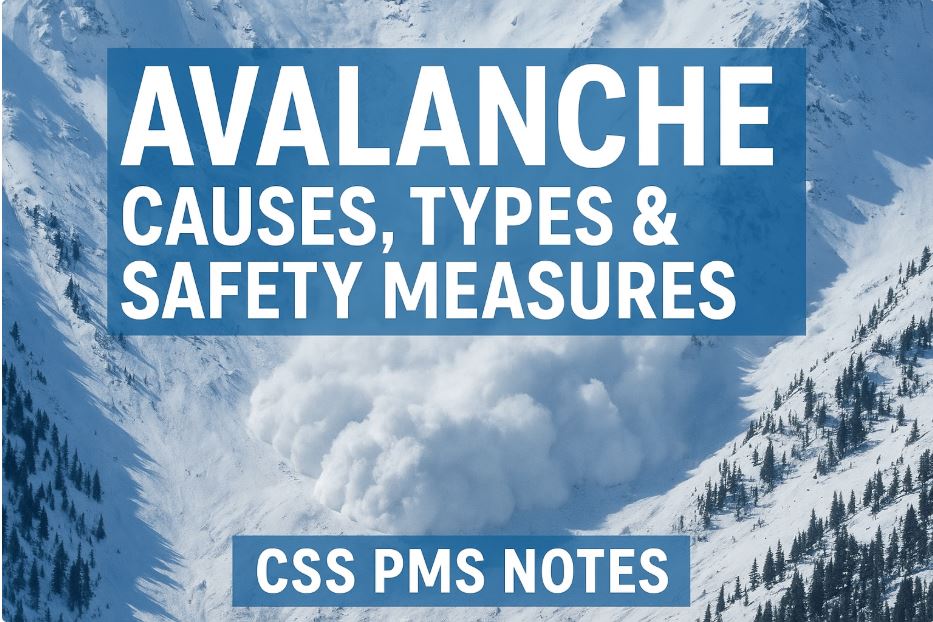Avalanche: Causes, Types, and Safety Measures Explained Simply

Imagine standing on a snowy mountain when suddenly, the ground begins to move.
Within seconds, tons of snow, ice, and rock rush downhill — that’s an avalanche.
It is one of nature’s fastest and most dangerous disasters. Let’s explore what it is, how it forms, its causes, types, and how we can stay safe.
What Is an Avalanche?
An avalanche is a sudden and rapid flow of snow, ice, rocks, or debris down a mountain slope.
It happens when a large mass of snow becomes unstable and slides under gravity.
Avalanches occur in mountainous areas where snow layers build up over time.
They are often triggered by natural causes like heavy snowfall or human activity such as skiing and construction.
Avalanches are a major natural hazard that destroy property, forests, and lives.
Scientists and the United Nations Office for Disaster Risk Reduction (UNDRR) classify it under code MH0801, a category for mass movement hazards.
How Avalanches Form
Understanding how avalanches form is key to preventing them.
Snow accumulates layer by layer on steep slopes. When new snow piles on weak or icy layers, the snowpack becomes unstable.
If a trigger occurs — like a loud sound, skier movement, strong wind, or rapid warming — the snow layer breaks loose.
Gravity pulls the mass downward at great speed. Several factors affect formation:
- Slope angle: Most avalanches occur on slopes between 30°–45°.
- Weather conditions: Heavy snowfall, wind, and sudden warming increase the risk.
- Terrain features: Rocks, cliffs, and uneven surfaces help snow slide easily.
Types of Avalanches
Avalanches come in different forms depending on what moves and how fast it travels.
1. Snow Avalanches
The most common type. It happens when a thick layer of snow slides down rapidly.
2. Ice Avalanches
These occur when ice chunks break from glaciers and rush downhill.
3. Rock Avalanches
Made of dry rocks and debris. They often happen during earthquakes or heavy rains.
4. Debris Avalanches
A mix of snow, mud, rock, and vegetation — these can bury entire villages.
| Type | Main Material | Speed | Common Cause |
|---|---|---|---|
| Snow | Snow & Ice | Very fast | Heavy snowfall |
| Ice | Glacier ice | Moderate | Melting, cracking |
| Rock | Rocks & debris | Fast | Earthquakes |
| Debris | Mud, snow, rock | Variable | Rain, heat |
Causes of Avalanches
Avalanches occur due to both natural and human causes.
🔹 Natural Causes
- Heavy snowfall increases pressure on snow layers.
- Strong winds move snow unevenly, creating unstable spots.
- Sudden temperature rise weakens snowpack.
- Earthquakes and storms shake snow layers loose.
🔹 Human Causes
- Skiing, snowmobiles, or construction disturb weak snow layers.
- Explosions and loud sounds can trigger a slide.
Climate change is also increasing avalanche risk by changing snowfall and temperature patterns.
Effects and Dangers of Avalanches
Avalanches can cause massive destruction in minutes.
They can:
- Destroy homes, roads, and forests.
- Block rivers and cause floods.
- Kill wildlife and damage ecosystems.
- Stop tourism and mountain trade routes.
They are serious avalanche hazards that need global attention.
Avalanche Prevention and Control
Prevention helps reduce disaster risk. Scientists and governments use many avalanche prevention and control methods such as:
- Snow barriers and retaining walls on steep slopes.
- Controlled explosions to release small slides safely.
- Avalanche prediction systems using satellites and sensors.
- Education and awareness programs for people living near mountains.
In high-risk zones, disaster management teams monitor snowfall daily.
This helps issue warnings before an avalanche occurs.
Safety Measures for Mountain Travelers
Travelers in snowy regions must follow avalanche safety rules:
- Always check avalanche warnings before hiking or skiing.
- Avoid steep slopes after heavy snow or rapid warming.
- Carry rescue gear like shovels, beacons, and probes.
- Travel with trained guides.
- Inform someone about your route and return time.
Simple habits can save lives in dangerous mountains.
Avalanche-Prone Regions
Some parts of the world face avalanches every winter.
Major regions include:
- Himalayas in Asia
- Alps in Europe
- Rocky Mountains in North America
- Andes in South America
These areas have monitoring systems that help predict and manage avalanche hazards.
UNDRR and Avalanche Risk Management
The UNDRR lists avalanches under mass movement hazards (MH0801).
It works globally to reduce avalanche risk through early warning systems, community awareness, and sustainable mountain development.
Understanding avalanche risk is part of building a safer planet.
Conclusion: Living Safely with Nature
An avalanche shows how powerful nature can be.
But with knowledge, science, and safety measures, we can reduce risks.
Every traveler, climber, and local resident must learn how avalanches form and how to stay safe.
Respect the mountains — and they will respect you back.